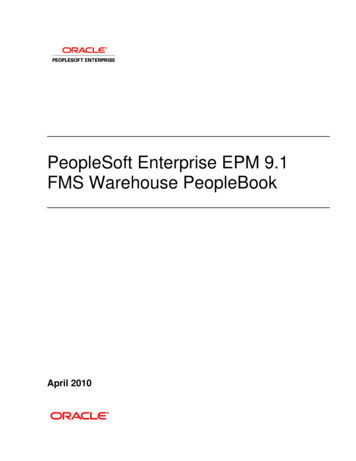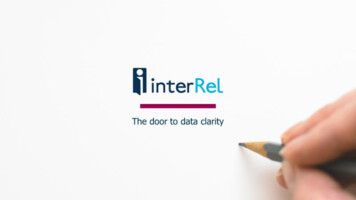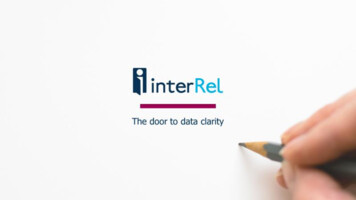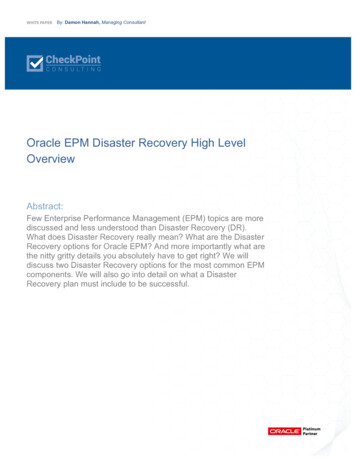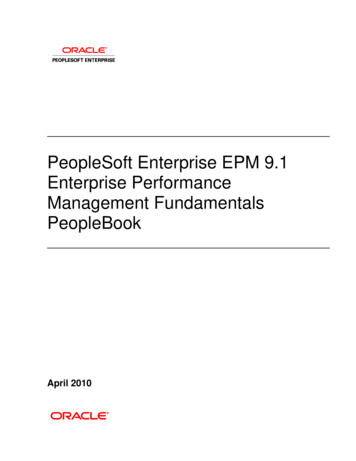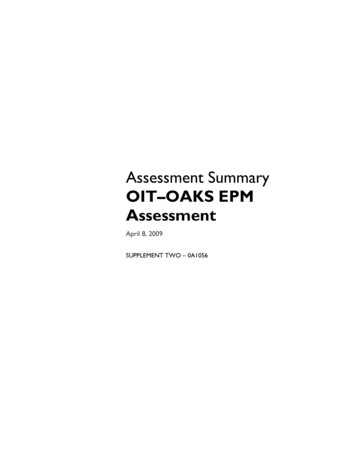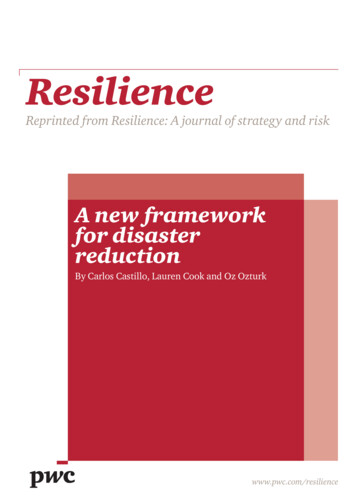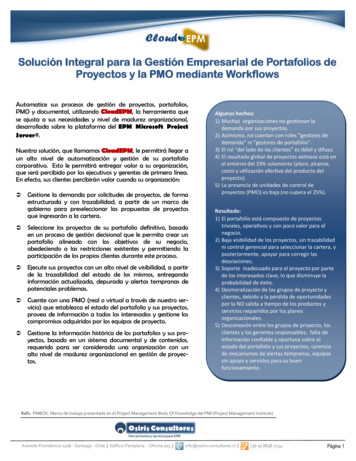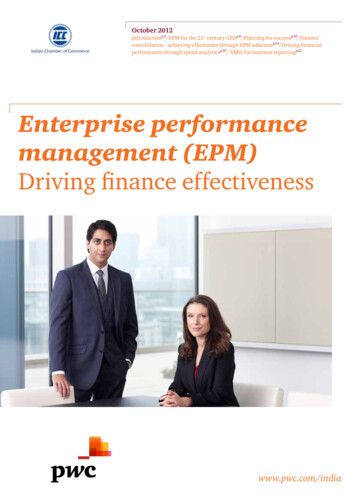
Transcription
October 2012Introductionp3/EPM for the 21st century CFOp4/Planning for successp10/Financeconsolidation - achieving efficiencies through EPM solutionsp14/Driving financialperformance through spend analyticsp19/ XBRL for business reporting p21Enterprise performancemanagement (EPM)Driving finance effectivenesswww.pwc.com/india
PrefaceRajiv MundhraPresident - Indian Chamber of CommerceAmbarish DasguptaExecutive Director/Partner and ConsultingLeader - PwC IndiaThe profile of the Chief Financial Officer (CFO) haschanged immeasurably in the last decade. Whilemuch has been written about the new expectationsfrom the CFO to be an effective business partner and achange catalyst, the reality on the ground is that mostfinance functions feel overworked and substantiallyhandicapped on their efficiency index.In last few years, advancement of technology has beensignificant, especially for the office of the CFO. But theperfect harmony of an optimised process balanced withan apt scalable technology infrastructure has oftenremained an unfulfilled dream. Enterprise performancemanagement (EPM) framework provides that bridgebetween process and technology to drive performance.While the cult of EPM has existed for several years, it isonly in the recent times, that there is a focussed attentiontowards leveraging the framework for tangible corporategains. In our view, EPM comprises the following discrete,yet overlapping layers of attributes:1. Business strategy formulation and identification ofKPIs to measure performance to link up to the strategy2. Planning, budgeting and forecasting3. Financial consolidation for uniform businessperformance analysis4. Advanced analytics for key business driversThis publication attempts to identify the currentchallenges in EPM implementation for these attributesand how the finance communities are trying to scaleup. We have shared relevant best practices and industrylearnings to provide a “hands on” view of EPM for theactual users in the finance teams.As it is true for any framework, the application ofknowledge is what differentiates the winners fromthe laggards. The post-recession world will have newsets of demands on the CFOs with intense focus onmeasurement and delivery. Application of EPM in reallife will be a key differentiating factor to decide theefficiency and effectiveness of the finance function.Enterprise performance management (EPM)3
EPM for the 21st century CFOTools, techniques and trendsThe term CFO (Chief Finance Officer) is more ofan anachronism in the 21st century. Gone are thedays when the responsibility was only to preparethe statutory financial reports and play the role of abookkeeper for the organisation. The expectation nowis to play the role of a strategic advisor to the boardand be the custodian of the enterprise performancemanagement (EPM).EPM is about ensuring that the organisation istranslating its strategy into measurable indicators andtargets and monitoring its performance. It also meansthat there is an effective people alignment across theenterprise where the individual key result areas (KRAs)are aligned with the corporate objectives. Moreover,the reward and recognition mechanism encouragesbehaviours, which directly contribute to the overallstrategy of the organisation in a direct or indirectmanner. This ensures that the organisation runs likea well-oiled machine where every part of the same iscontributing to the overall success.4ICC - PwCComponents of EPMIn the classical model, EPM framework comprises threemain components:a. Strategy to plan process: It cascades enterprisevision into financial and non-financial metricsand creates accountability to enhance businessperformance across the organisationb. Measure to forecast process: It is the agile dayto-day analysis, weekly and monthly reporting,modelling and decision-support activities required toadjust business objectives and the forecastc. Recognise to reward process: It sets out theindividual behaviours, delivery metrics and rewardmodel to align people’s performance to businessperformance
Implementing an EPM frameworkImplementing an EPM framework requires a focus onsome of the key areas such as:Alignment of key performance indicators: Ifthe objective of the organisation is to maximiseshareholder value, then return on capital employed(ROCE) will be one of the key indicators of success,not earnings before interest, tax, depreciation andamortisation (EBITDA). This insight is critical to driveperformance management because the former metricis a combination of the operational efficiency withthe asset turnover while the latter is just a measureof operational efficiency alone. Once the ROCE hasbeen zeroed into, the next task is to drill down to thecomponents and subcomponents of ROCE and buildthe entire driver tree, which can then be cascaded tothe organisation.KPI driver treeIllustration of a driver tree for ROCEEnterprise performance management (EPM)5
Reducing the volume and complexity ofmanagement reports: There are organizations whichhave more than 200 reports and 150 KPIs. The questionto ask is whether the senior management has the timeto read and understand these reports and whether theKPIs are truly that. The trend is to create a top-levelreal-time cockpit for the CFOs with an ability of seethe exceptions (business rules-based alerts) and drilldown to specific information that requires attention.This implements the adage “less is more” and preventsthe management from getting overwhelmed withinformation, yet allowing access to full detail.Here is an example where information is presented inlogical tabs or sections with a dashboard index thatallows the user to prioritise, and where the selectionof filters and dropdowns enhances usability andcustomisation.Focussing on reducing the overall budget cycletime: Many organisations take three to six months tocomplete their annual budgeting exercise. This bringsup the question, “When does the organisation get toimplement the plan, which has taken a good quarter ofa year to formulate?” The key reasons for such extendedcycle times are reliable availability of the actualnumbers, defined and controlled processes for bridgingthe gap between the ‘top-down’ and ‘bottom-up’approaches to planning that most organisations take,and finally the granularity or detail of the planningprocess. This is because the law of diminishing returnsthat applies as increased detail in planning may notnecessarily increase the effectiveness of the process.6ICC - PwC
Approximately how much time does it currentlytake your company to prepare its budget?Approximately how long does it take yourcompany to generate a forecast?Findings of the survey conducted by CFO research servicesand PwC in 2011A joined up planning processCreating a plan at the beginning of each year may soonbecome an academic exercise if rolling forecasts are notembedded into the process. The variance analysis willnot truly reveal the root cause of the focus area and canonly result in incorrect conclusions. The ability to dodriver-based planning using non-financial or leadingindicators like customer satisfaction and complaints forforecasting sales and external data inputs, like futurecost of commodities for forecasting raw material costs,becomes an integral part of such rolling plans.The advancements in technology by way of automatedplanning workflow tools, easier bottom-up dataavailability by means of automated templates andintuitive dashboards and reports with focus on causesof variance are some of the key enablers for makingthis a reality. A holistic and inter-related process whichlinks corporate objectives to KPIs and then closes thefeedback loop by accurately reporting the data andlinks it to individual objectives provides the necessaryplatform for improving the effectiveness and efficiencyof the planning process.Understanding the business and increasing theaccuracy of the plan numbers: Benchmarks confirmthat there is an opportunity to generate considerablevalue by making the planning process more accurate.An empirical study by PwC suggested that forcompanies with a forecasting accuracy of /- 5% ormore, shareholder value increased by 46% in the lastthree years as opposed to just 36% increase for therest. At the heart of the accuracy lies the sanctity of theassumptions and the model used for deriving the planvalues. An important aspect of this model is the useof non-financial KPIs and external information whichis still not very widely used as an integral part of theplanning process.Enterprise performance management (EPM)7
External market information, not internal data, is most likely to improve the quality of forecastsIn your opinion, which of the following factors are most likely to lead to variances between forecasts and actualperformance at your company?Findings of the survey conducted by CFO research services and PwC in 2011Shifting focus from mere compliance to trueleadership: No other office embodies this change inthe imperative more than the office of the CFO. Thetrend is to make your annual reports and disclosures‘compelling’ and not just ‘compliant’. The need of thehour is to provide the answers to the ‘whys’ and ‘whatifs’ and not just of ‘whats’ and ‘hows’. This is wheredrawing analysis and insight from the data becomestruly important. Investments in the state-of-the-artERP and other transactional systems are efficientin capturing transactions so that organisations canprepare even daily balance sheets and profit-and-lossaccount statements if they want to.However, the challenge lies in understanding thereasons behind these numbers. Financial analyticsstarting from procurement analytics to cost ofproduction and subsequently to cost of distributionis the key focus for understanding the drivers of costand for optimising it. This also requires capturingexternal data (like inflation, taxation changes, futureprices of commodities, transportation cost changes)and embedding them with the internal cost data(like production costs, storage costs, overheads)to arrive at strategic decisions (like buy vs. builddecisions, production and warehouse location, contractmanagement) along with operational decisions (likeraw material mix optimisation, balancing distribution8ICC - PwCvs. inventory carrying costs) to decide which productsto focus on.Building a smart and efficient financial close toreport (C2R) cycle: Externally, stakeholders andregulators demand more transparent and reliableinformation in less time. Internally, business leadersrequire fast and accurate information to supportsmart, informed business decisions. This requiresorganisations to do the following: Improve accountability and control throughoutthe cycle: Technology as an enabler can play abig role in providing Web-based workflow andcollaboration tools, which automate manual activityand provide centralised access to the documents Simplify and standardise processes to eliminatecomplexity and inconsistencies: Usually the timespent in reconciliation and format changes of thedata can be addressed by defining the data lineageand doing away with multiple versions and formatsof the same report Enhance effectiveness by assigning clear roles,measuring effectively and linking them with thereward cycle: It is important to define the roles ofother supporting functions like legal, treasury, IT andinvestor relations with specific activities and cleardue dates for completion and approval
Harvesting the investments in process and ITchanges: The onus is on the finance function to keepan eye on realising the benefits of the investments inERP and other technologies. In a recent benchmarkstudy conducted by PwC among the Indian CFOs(State of Finance function in India – 2010), it becameevident that transactional costs have increasedparticularly for average performing finance functions,whose transactional costs are 40% higher thantheir top quartile counterparts. Standardisationand automation are not merely finance subjects,but are pervasive across the organisation’s valuechain. However, there is a danger in focussing onpoint solutions rather than achieving sustainableperformance improvement.Many organisations have embraced the above trendsand aligned their processes with technologicalenablement to improve the effectiveness of the financefunction. Instead of just depending on spreadsheetsfor doing the planning and forecasting, organisationsare investing in robust planning tools which not onlyprovide a reliable workflow with an audit trail, butalso provide abilities for driver-based what-if analysisand scenario planning.Advancements in data storage and reportingtechnologies have enabled organisations to have oneconsistent version of the truth available centrallyso that manual reconciliations between multiplespreadsheets can be eliminated.More time is available now for analysis of the datausing intuitive visualisation techniques on a realtime basis rather than just collecting and reconcilingdata. Advancements in the mode of informationdissemination includes use of handheld devices likesmartphones and iPads for not only participatingactively in the planning and budgeting process, but alsofor receiving timely alerts and dashboards to deriveinsights from the data.Data mining technologies now enable organisationsto prepare causal and predictive models which lookat leading or forward-looking indicators in order toincrease the effectiveness of the planning process.Concepts on big data analytics are helping organisationsmake sense of both structured and unstructuredcontent generated either inside or external to theorganisation in order to understand customer trends,competitive dynamics, vendor behaviour, productionand supply chain efficiency.From being a custodian of the bookkeepingrequirements in the 19th century to cementing itsstatus and influence over the course of recessionaryperiods in the early 20th century, the role of the financefunction has now evolved in the early 21st century todeliver business insights. Organisations are navigatingthemselves against ever-complex regulatory andcompetitive forces and have to grapple with potentiallydisruptive technological innovations. The 21st centuryCFO needs to rise to the occasion and perform the‘business partnering’ role now expected by many CEOs.Enterprise performance management (EPM)9
Planning for successThe financial crisis provided an acid test for theeffectiveness of planning capabilities. Smartbusinesses saw the warnings and responded quickly,while others were caught unawares. Bringing planningcapabilities up to the mark is going to be equallyimportant in anticipating and making the most of theopportunities ahead.Some insightsWe recently published the annual benchmark report,which outlines the latest findings of our benchmarkanalysis of more than 200 participating companies. Thereport includes an in-depth comparative assessment ofthe finance functions of 72 companies with operationsaround the world, which were carried out betweenJanuary and December 2011.While 80% of benchmark participants rely on theaccuracy of their forecasts, only 45% believe they arematerially correct. At 120 elapsed days for budgetsand 19 days for forecasts, the typical cycle times arealso far too long to have much validity in today’sfluctuating conditions (see figure below). The moreagile businesses are concentrating on the key businessdrivers (top-down) rather than spending time buildingbudgets from the bottom up. Cash flow projections andscenario analysis are often an integral part of theseforecasts, highlighting the increased emphasis on riskfactors and probability of outcomes.Budgeting and forecasting cycle (days)10ICC - PwCOther key findings from that report are as follows: Historical weaknesses in the budgeting andforecasting process persist, limiting the perceivedvalue of the financial planning process within theorganization Business changes and uncertainty are leading factorscited as causes for planning variability from actualperformance Extensive detail in account planning often extendsplanning cycle times, making the information datedby the time the outputs are finalised The concept of continuous forecasting based onchanging business conditions (versus predeterminedmonthly or quarterly projections) is hitting the rightchords both with finance and operations Rolling forecasts are no longer an emerging trend butbecoming an established leading practice, extendingthe forecasting horizon to rolling quarters beyondyear-end to provide additional visibility Increasing forecasting accuracy is on top of theimprovement agenda; however it remains an elusivetarget for many There is an increased need to link sales andoperational planning activities and outputs with thefinancial planning process Best-of-breed financial planning applications cansignificantly improve the overall planning processand reduce manual planning activities and disparatespreadsheets
Where is the scope for improvement?In theory, superior yet efficiently gained insight stemsfrom combining: information on actual performance with budget-related forecasts a well as forecasts rolling into the (near) futureBut in practice, planning and budgeting are oftendisconnected processes, with only actual performancebeing reported against the budget. Luckily more andmore organisations at least link budgeting to businessplanning, adding forecasts to their reporting; yet onlya few also implement rolling forecasting, moving toan ongoing management dialogue, making planning acontinuous process, and enabling a drastic reduction intime and effort needed to plan and budget.Enterprise performance management (EPM)11
Subject areaCommon practiceLeading practiceStrategicplanning Elements of a steering concept are mainlydefined; however, effects are not consideredconsistently (e.g. client-supplier relations). Steering concept is fully defined and basedon business model. Profit centers are the main steering objects. Products/Orders and cost centers are definedas further steering objects. Allocations are established, but are complex. Service relationships are handledinconsistently regarding actual and plan. Reporting dimensions are defined. Profit, cost and service centers aredifferentiated. These are the main steeringobjects. Further steering objects are defined andexplained. Allocations are established along the valuechain, show a low complexity and arereduced to a minimum. Steering objects and service relationshipsare handled consistently regarding actualand plan.Operationalplanning andbudgeting Top-down/bottom-up planning is based onbusiness targets; however, they are either notor they are poorly cascaded to divisions The various operational plans are notsufficiently integrated More than two reconciliation cycles arenecessary Controlling translates parts of the planninginto operational function Divisions are involved in the planning and takeresponsibility for the results MS Excel is used as a supporting tool. Operational planning is derived fromstrategic planning and rolling forecast. Blended (top-down/bottom-up) planning isbased on cascaded business targets. No more than one reconciliation cycle isnecessary. Planning is able to differentiate betweenongoing expenditures and (strategic)actions/measures. Controlling is the process driver;it challenges results and providesrecommendations. Operational planning is handled by thedivision’s responsible. Only integrated planning systems are used.Forecasting Quarterly year-end forecasts Rolling forecast with fixed time horizon Process focuses on drivers of results. Process focuses on performance drivers Forecast is a “controlling only” issue.Operational departments are involved on time. Forecast is an overall issue. Relevantoperational departments are involved andintegrated in the process. Data relies mainly on internal information. Forecast is calculated based on realisedcumulative actual plus remaining plan(corrected for main effects on results). Market and distribution data are enhancedby external information. Forecast covers all relevant reportingsystems (P&L, cash flow and balancesheet). These figures are used to derive allperformance KPIs. Last forecast of the year mainly reflects thebudget planning for the following year.12ICC - PwC
We believe that transforming the financial planningprocess extends well beyond just making the processor function more robust and this can be achieved byintegrating the system change with simultaneouschanges in the management’s approach to the planningprocess and organisational culture, without which theprocess changes will not have the intended impact.Technology is an essential enabler of any financialplanning process and a sustained transformation inthe process cannot occur without strong supportingtechnology.A success storyOur client is a Fortune 500 automotive major based outof India. The company wanted to manage its detailed,albeit age-old, Excel-based planning process in asystem. This organisation wide planning applicationtook into account both commercial and passengerdivisions, all the plants across India and the corporateplanning divisions. Also, high efforts were requiredin the preparation of these Excel-based budgets.The communication of budget files mostly throughemail was leading to a lag in data availability at thecorporate level. Automation and the ability for detailedanalysis was the key requirement from the systemimplementation.BenefitsThe Planning applications enabled the companyto achieve significant efficiencies in reportingby standardising processes globally. The systemgreatly accelerated the company’s budgeting andforecasting reporting process by facilitating earlieraccess to information. The new system providesone common, scalable and flexible platform forreporting across all of its entities. For the first time,the company can report variances across variousbusiness units across different plants.ConclusionOne of the biggest challenges in transforming theplanning process is gaining buy-in and alignmentacross the organisation. The success of a newfinancial planning process is purely dependent onthe tone-at-the-top. Another critical componentof transformation success is also dependent onthe operations team, which gathers all data inputsand addresses the deviations on the ground forthe forecasting process. Any change shouldn’t beviewed within the organisation as another level ofbureaucracy or a command from the head office,since it is the people on the ground that have to takeappropriate actions to provide continuous analysis.SolutionWe conducted a detailed requirements study tounderstand and document the budgeting and planningneeds based on the current and future expansion plans.We worked closely with a wide range of operationalbusiness users to assist and guide our client in breakingdown the planning silos which had evolved within theorganisation. We focussed on automating budgetingand forecasting processes to provide faster, moreconsistent and meaningful numbers while reducingthe planning cycle from several weeks to just daysfor specific business units. Our phased approachsupported a global roll-out based on a common datamodel, while allowing appropriate local differencesand incorporating the lessons learned during eachimplementationEnterprise performance management (EPM)13
Finance consolidation achieving efficiencies throughEPM solutionsThe world of the CFO has changed beyond recognitionin the last two decades. From being a custodian offinancial numbers, the CFO is now increasingly beingconsidered as a valued business partner, who shapesthe business strategies and works closely with theCEO to drive enterprise priorities. The average CFOtoday gets to spend far less time on his routine financeand accounting processes than his predecessors. Hehas to often assume an ambidextrous role betweenhis stewardship responsibilities towards finance andstrategist responsibilities towards the business.In a recent CFO survey we conducted, 30% of the CFOssurveyed in India recognised ‘building the capabilityto provide business insights’ as a key focus area for thenext 12 months. However, the finance function is stilltrying to come to terms with its new role as the businesspartner. The surveys indicate this dilemma through thefollowing statistics: 63% of respondents indicated that they havea finance team of more than 25 people However, 48% of these teams have less thanfive people dedicated to business partneringand decision support roles 58% of the respondents also indicated thattheir finance team spends less than 20% of itstime on value-added analysis and planningand its time is consumed to a large extent bydata crunching and manual routinesThere is a clear mismatch between the expectationsand enablers in the finance teams. Organisationsaround the world are increasingly realising theneed to meet this gap through a host of initiativesand interventions such as process reengineering,technology innovations and shared service, andoutsourcing of transactional functions.In many ways, enterprise performance management(EPM) embodies the solution that brings togetherthe best processes and technologies under a commonframework. EPM principles are based on the followingkey parameters: Gathering the right information, analysingit, reporting on it and applying it across theenterprise Doing this in the optimal manner to createbusiness insight and agility in supporting keybusiness decisions Aligning the business unit, team and individualbehaviour and rewards to the business vision Integrating all key performance managementprocesses such as the process of setting thestrategy set, modelling outcome scenarios,agreeing and cascading the budget and KPIs Ensuring that processes, data, systems and theorganisation and behaviours of people work inunison to drive enhanced business performanceThere is an increasing trend in adopting EPM principlesand techniques (including technology) in performingsome of the fundamental finance processes. In anotherarticle, we have explored the leverage of EPM forfinancial planning, budgeting and forecasting. Thiswhitepaper explores the usage of EPM for yet anothercore financial function—fiscal consolidation forreporting purposes.Consolidated financial statements:Regulatory needsSection 212 of the Companies Act, 1956, specifies thatthe balance sheet of a holding company should includethe following information about its subsidiaries A copy of the balance- sheet of the subsidiary A copy of its profit and loss account A copy of the report of its board of directors A copy of the report of its auditors A statement of the holding company’s interest in thesubsidiary as follows:a. The extent of the holding company’s interest inthe subsidiary at the end of the last financial yearof the subsidiary or of the last financial year ofthe holding companyb. The net aggregate amount of profits of subsidiaryafter deducting losses so far as it concerns themembers of the holding company and is not dealtwith in its accountsc. Any change in the holding company’s interest inthe subsidiary14ICC - PwC
The Indian Accounting Standards 14(Amalgamations) and 21 (Consolidation ofFinancial Statements) lay down the basic accountingfoundation of finance consolidation. In addition,the IASB has recently issued IFRS 10 - ConsolidatedFinancial Statements, which establishes principlesfor the presentation and preparation of consolidatedfinancial statements when an entity controls one ormore other entities. The IFRS 10 builds on existingprinciples by identifying the concept of controlas the factor that determines whether an entityshould be included within the consolidated financialstatement of the parent company.Consolidation: Present scenarioAt present, most of the Indian companies performconsolidation using spreadsheet-based models.Preparing consolidated financial statementsusing such basic methods means that the financefunction spends more time in reconciling numbersrather than analysing the results. Also, the auditorswho audit these models essentially rely on manualcontrols (built into these models) to comment ona true and fair view of the financial statements oftheir client. Traditionally, these suffer from thefollowing limitations because of their dependencyon human activities:Key challengesExamplesToo much timespent on theperiod-end close Intercompany matching is difficultdue to large differences Inaccurate source operationaldata resulting in rework Significant number of adjustingentries Manual workarounds and datare-input Excessive use of spreadsheets Lack of or compliance withaccounting time tableInformation too latefor decision-making Slow period-end close Professional desire to get 100%accurate information Organisational complexity –multiple subsidiaries, statutoryand management reporting Excessive review of draft results Lack of impetus for change Complexity of reporting –including non-financial dataLack of trust infinancial data Inconsistent data definitions andnon-standard chart of accounts Non-standard procedures Potential errors due to manualprocesses, interfaces and use ofspreadsheets Lack of automation – lack ofeffective interfaces Standalone and non-standardsystems Poor reporting toolsInsufficient time foranalysis of financialresults – no ‘valueaddition’ Slow period-end close – spendingtoo much time on producing theaccounts People and culture issues – lowskills and limited ability to providevalue-adding support False belief that things are inorder Lack of awareness about thepotential for more value-addinganalytical workEnterprise performance management (EPM)15
EPM solutions for financialconsolidationTo help overcome these challenges, finance functionsare focussing on a mix of process improvementsand technology innovations to reduce cycle time,improve controls and analytics and drive downcosts. In the following section we have discussedthe standar
Application of EPM in real . External market information, not internal data, is most likely to improve the quality of forecasts . Enterprise performance management (EPM) 9 Harvesting the investments in process and IT changes: The onus is on the finance function to keep an eye on realising the benefits of the investments in .

